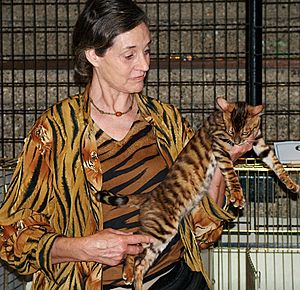Toyger facts for kids
Quick facts for kids Toyger |
|
|---|---|
 |
|
| Breed standards | |
| TICA | standard |
| Domestic cat (Felis catus) | |
The Toyger is a special kind of house cat. It was bred to look like a small "toy tiger." Its striped coat really reminds you of a wild tiger!
This breed started in the 1980s. The person who created it, Judy Sugden, wanted to help people care about real tigers. She hoped that seeing a cat like a tiger would make people want to protect tigers in the wild.
The Toyger cat was officially recognized by The International Cat Association (TICA). It became a full championship breed in 2012. This means Toygers can now compete in cat shows. In 2012, there were about 20 Toyger breeders in the United States. Around 15 more breeders were in other parts of the world. By 2020, 469 Toygers were listed in a special cat database called Pawpeds.
History of the Toyger
The Toyger breed began in the 1980s in the United States. Judy Sugden was a cat breeder. She was studying the stripe patterns on tabby cats. She noticed some unique spots on one of her cats. These tiny spots were on the cat's face, where there usually aren't clear patterns. This discovery made her think that a cat could have a round, tiger-like face pattern.
To make her "toy tiger" dream come true, Judy imported a male cat from India. This cat had special spots on its head. Over several years, about 40 different house cats were chosen. They came from many countries. Some were Bengal cats, known for their wild look. Others were regular short-haired cats with cool stripes. Each cat helped add a specific trait to the new Toyger breed.
Judy Sugden is the daughter of Jean Mill. Jean Mill is famous for creating the Bengal cat breed. It's said that the shiny, glittery look in Bengal, Egyptian Mau, and Toyger cats all comes from one special cat. This cat, named Millwood Tory of Delhi, was found by Jean Mill in India.
In 1993, TICA allowed Toygers to be registered. This was the first step for the breed. By 2000, they could be shown in special new breed classes. Finally, in February 2007, Toygers were fully recognized. They could then compete for championships in cat shows.
In 2020, TICA officially recognized the Toyger Club. This club helps support Toyger owners and breeders.
What Makes a Toyger Special?
The Toyger has specific features that make it look like a mini tiger. Here are some of the main things that make a Toyger unique:
- Head Shape: Toygers have a medium-sized, oval head. Their muzzle (the part with the nose and mouth) is strong and rounded. It looks a bit like an upside-down heart when you see their face from the front.
- Ears: Their ears are small and round. They are set wide apart and point slightly towards the eyes. Short, thick fur on the ears is preferred.
- Eyes: Toyger eyes are medium-sized and round. They are set wide apart and a bit deep in the face. A rich, dark eye color is best.
- Nose: The nose is strong, long, and wide. It gets wider towards the end, becoming as wide as the space between the eyes.
- Body: Toygers have a medium to long body. It's muscular and rounded, looking strong but not bulky.
- Legs and Feet: Their legs are medium length. The space between the ground and their body is about the same as the depth of their body. They have very strong bones.
- Tail: The tail is very long and not too thick. It tapers slightly to a blunt, rounded tip. The fur on the tail is short and dense.
- Muscles: Toygers look very muscular and athletic. This is especially true for young male cats.
- Coat Length: The fur on a Toyger is short all over. Sometimes, the fur around their cheeks and neck can be a bit longer, like a small ruff.
- Color: The stripes on a Toyger can be black, brown, or even tan. Very dark stripes are preferred. The background color of their fur should be a bright pumpkin orange. The lighter parts of their fur should be as light as possible, almost white.
- Stripe Pattern: Toygers have a "mackerel tabby" pattern. This means their stripes are clear and sharp, standing out strongly against the background color.
- Body Stripes: The stripes on their body usually go up and down (vertically). They also have stripes that go all the way around their neck, legs, and tail. Bold, braided, and uneven stripes are liked. Their belly and the inside of their legs must also have markings. Their paw pads and the tip of their tail should be black.
- Face Markings: The stripes and markings on their face go in circles around their face. They should not have traditional tabby lines that spread out from the face. It's nice if they have lighter, almost white "thumb marks" on the back of their ears. They should also have a natural "makeup" look. This means black, mascara-like markings around their eyes and white areas that look like spectacles. Their mouth should have black "lipstick" markings.
See also
 In Spanish: Gato Toyger para niños
In Spanish: Gato Toyger para niños


